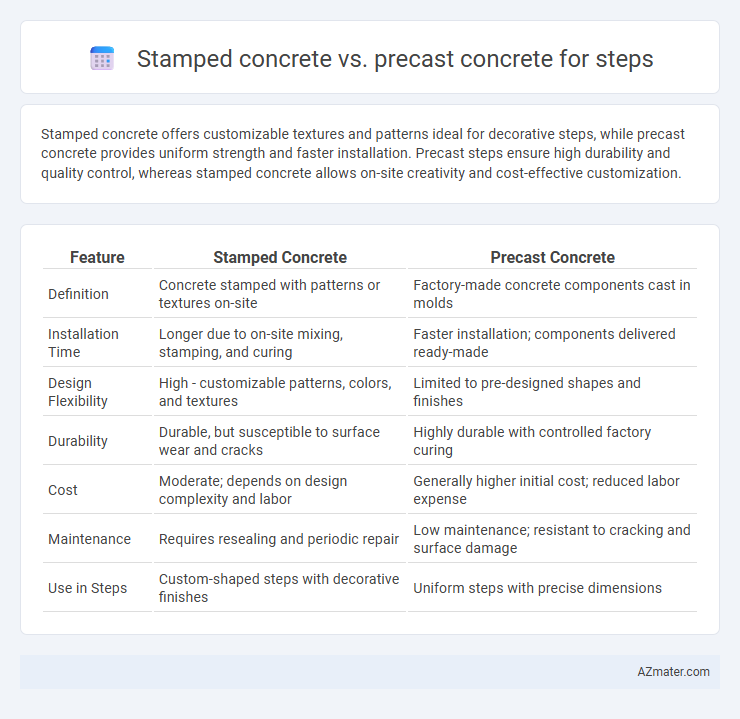Stamped concrete offers customizable textures and patterns ideal for decorative steps, while precast concrete provides uniform strength and faster installation. Precast steps ensure high durability and quality control, whereas stamped concrete allows on-site creativity and cost-effective customization.
Table of Comparison
| Feature | Stamped Concrete | Precast Concrete |
|---|---|---|
| Definition | Concrete stamped with patterns or textures on-site | Factory-made concrete components cast in molds |
| Installation Time | Longer due to on-site mixing, stamping, and curing | Faster installation; components delivered ready-made |
| Design Flexibility | High - customizable patterns, colors, and textures | Limited to pre-designed shapes and finishes |
| Durability | Durable, but susceptible to surface wear and cracks | Highly durable with controlled factory curing |
| Cost | Moderate; depends on design complexity and labor | Generally higher initial cost; reduced labor expense |
| Maintenance | Requires resealing and periodic repair | Low maintenance; resistant to cracking and surface damage |
| Use in Steps | Custom-shaped steps with decorative finishes | Uniform steps with precise dimensions |
Introduction to Stamped Concrete and Precast Concrete Steps
Stamped concrete steps offer a customizable surface with intricate patterns and textures that mimic natural materials like stone or brick, providing aesthetic appeal and seamless integration with surrounding patios or walkways. Precast concrete steps are factory-made, ensuring consistent quality, rapid installation, and enhanced durability due to controlled manufacturing conditions, making them ideal for standardized designs and quick project completion. Both options provide robust, long-lasting solutions, with stamped concrete emphasizing decorative versatility and precast concrete prioritizing precision and efficiency.
Material Composition and Manufacturing Process
Stamped concrete consists of a mixture of cement, sand, and aggregate with colorants and hardeners added before being poured and imprinted with patterns on-site, allowing customization in texture and design. Precast concrete for steps is manufactured in controlled factory environments using high-strength concrete mixes molded into standardized shapes, ensuring uniform quality and faster installation. The differences in material composition and manufacturing process influence durability, finish precision, and installation time for step construction.
Design and Aesthetic Options
Stamped concrete offers extensive design versatility with customizable patterns, textures, and colors that mimic natural stone, brick, or wood, providing a seamless and cohesive appearance for steps. Precast concrete steps come in predetermined shapes and finishes, delivering consistent quality and durability but limited flexibility in design customization. Choice between stamped and precast concrete depends on the desired balance between unique aesthetic options and uniform, time-efficient installation.
Installation Process and Timeframe
Stamped concrete installation involves pouring and shaping concrete on-site with patterns and textures applied before it cures, requiring skilled labor and typically aging 24 to 48 hours for initial curing. Precast concrete steps are manufactured in controlled factory settings, allowing rapid on-site assembly and minimizing installation time to just a few hours or a day, depending on site prep. The controlled production of precast concrete offers consistent quality and faster turnaround compared to stamped concrete's longer curing and customization timeframes.
Durability and Weather Resistance
Stamped concrete offers excellent durability with a seamless surface that resists cracking and fading under typical weather conditions, making it ideal for aesthetic outdoor steps. Precast concrete provides superior weather resistance due to factory-controlled curing, ensuring consistent strength and reduced permeability against freeze-thaw cycles and moisture infiltration. Both options withstand heavy foot traffic, but precast concrete excels in extreme climates by maintaining structural integrity over time.
Maintenance Requirements
Stamped concrete steps require periodic resealing every 2 to 3 years to prevent surface wear and color fading, with occasional cleaning to avoid dirt buildup. Precast concrete steps demand minimal maintenance, generally involving only occasional cleaning and inspections for cracks or damage due to their factory-controlled quality and durability. Both options benefit from prompt repair of any chips or cracks to extend longevity and maintain aesthetic appeal.
Cost Comparison
Stamped concrete generally offers a lower initial cost for steps due to on-site installation and customizable patterns requiring less labor-intensive production. Precast concrete steps involve higher upfront costs tied to factory manufacturing, transportation, and crane placement but often reduce long-term maintenance expenses. Evaluating total project budget should consider material, labor, and lifecycle cost differences between stamped and precast concrete options.
Safety and Slip Resistance
Stamped concrete offers textured patterns that enhance slip resistance on steps, reducing the risk of slips and falls when properly sealed with anti-slip additives. Precast concrete steps often feature factory-applied coatings or finishes designed specifically for safety, providing consistent slip-resistant surfaces that meet standardized safety requirements. Both options contribute to safer steps, but stamped concrete allows for customizable textures while precast concrete ensures uniform slip resistance through controlled manufacturing processes.
Customization and Flexibility
Stamped concrete offers extensive customization options with various patterns, textures, and colors mimicking natural materials, allowing homeowners to create unique step designs tailored to specific aesthetic preferences. Precast concrete steps provide consistent quality and faster installation but are limited in design flexibility due to factory molds and standard sizes. For projects requiring personalized shapes and intricate detailing, stamped concrete stands out as the more adaptable solution compared to the uniformity of precast steps.
Which Concrete Step is Right for Your Project?
Stamped concrete offers customizable textures and patterns, ideal for decorative steps that blend seamlessly with outdoor landscapes, while precast concrete steps provide superior strength, uniformity, and faster installation due to factory-controlled manufacturing. Choosing between stamped and precast concrete depends on factors like aesthetic preference, budget constraints, project timeline, and structural requirements, with stamped concrete excelling in design flexibility and precast favored for durability and consistency. Assessing your project's design goals and environmental conditions will guide the selection of the concrete step that best meets both functional and visual demands.

Infographic: Stamped concrete vs Precast concrete for Step
 azmater.com
azmater.com